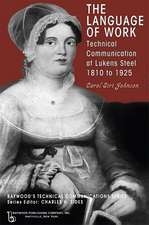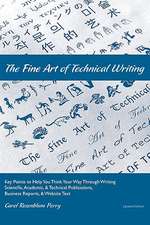Motives for Metaphor in Scientific and Technical Communication: Large Type Edition: Baywood's Technical Communications
Autor Timothy Giles, Charles Sidesen Limba Engleză Paperback – 29 mar 2017
Din seria Baywood's Technical Communications
- 5%
 Preț: 330.56 lei
Preț: 330.56 lei - 5%
 Preț: 496.09 lei
Preț: 496.09 lei - 5%
 Preț: 455.08 lei
Preț: 455.08 lei - 23%
 Preț: 414.24 lei
Preț: 414.24 lei - 5%
 Preț: 451.31 lei
Preț: 451.31 lei - 14%
 Preț: 318.90 lei
Preț: 318.90 lei - 17%
 Preț: 331.25 lei
Preț: 331.25 lei - 12%
 Preț: 333.67 lei
Preț: 333.67 lei - 18%
 Preț: 1056.80 lei
Preț: 1056.80 lei - 15%
 Preț: 639.47 lei
Preț: 639.47 lei - 25%
 Preț: 415.11 lei
Preț: 415.11 lei - 5%
 Preț: 392.32 lei
Preț: 392.32 lei - 25%
 Preț: 540.68 lei
Preț: 540.68 lei - 26%
 Preț: 442.64 lei
Preț: 442.64 lei - 5%
 Preț: 453.13 lei
Preț: 453.13 lei - 5%
 Preț: 496.09 lei
Preț: 496.09 lei - 5%
 Preț: 338.37 lei
Preț: 338.37 lei - 5%
 Preț: 453.33 lei
Preț: 453.33 lei - 26%
 Preț: 820.32 lei
Preț: 820.32 lei - 5%
 Preț: 458.23 lei
Preț: 458.23 lei -
 Preț: 422.59 lei
Preț: 422.59 lei - 26%
 Preț: 819.90 lei
Preț: 819.90 lei - 17%
 Preț: 639.77 lei
Preț: 639.77 lei -
 Preț: 479.09 lei
Preț: 479.09 lei - 5%
 Preț: 450.02 lei
Preț: 450.02 lei - 18%
 Preț: 721.16 lei
Preț: 721.16 lei -
 Preț: 356.18 lei
Preț: 356.18 lei -
 Preț: 489.00 lei
Preț: 489.00 lei - 23%
 Preț: 489.55 lei
Preț: 489.55 lei - 15%
 Preț: 638.95 lei
Preț: 638.95 lei - 57%
 Preț: 421.16 lei
Preț: 421.16 lei - 50%
 Preț: 365.39 lei
Preț: 365.39 lei
Preț: 298.99 lei
Preț vechi: 362.06 lei
-17% Nou
Puncte Express: 448
Preț estimativ în valută:
57.21€ • 59.73$ • 47.35£
57.21€ • 59.73$ • 47.35£
Carte tipărită la comandă
Livrare economică 05-19 aprilie
Preluare comenzi: 021 569.72.76
Specificații
ISBN-13: 9780415434409
ISBN-10: 0415434408
Pagini: 184
Dimensiuni: 152 x 229 x 17 mm
Greutate: 0.25 kg
Ediția:1
Editura: Taylor & Francis
Colecția Routledge
Seria Baywood's Technical Communications
Locul publicării:Oxford, United Kingdom
ISBN-10: 0415434408
Pagini: 184
Dimensiuni: 152 x 229 x 17 mm
Greutate: 0.25 kg
Ediția:1
Editura: Taylor & Francis
Colecția Routledge
Seria Baywood's Technical Communications
Locul publicării:Oxford, United Kingdom
Public țintă
Professional Practice & DevelopmentCuprins
Acknowledgments
Introduction: The Problem of Metaphor in Scientific and Technical Communication
Differentiating between Scientific and Technical Communication
Metaphor and Analogy
Summary of Chapters
Chapter One: Reintroducing Metaphor in the Technical Communication Classroom
Problem
Methodology
Some General Considerations of Metaphor
Technical Communication Textbooks
Science Writing Texts
Chapter Two: Metaphor in the Technical Communication Literature
Metaphor and the Computer
Technical Communication Theory
Technical Communication Pedagogy
Conclusion
Chapter Three: A Review of the Theories of Metaphor
Substitution Theory of Metaphor
Aristotle on Metaphor
Twentieth-Century Substitutionists
Nietzsche and Post-Modern Metaphor
The Tensionists: An Introduction to Interaction
The Interactionists
Metaphor as Epistemology
Conclusion
Chapter Four: The Metaphor of Mathematics: A Case Study of the Solar System Analogy
Scottish Natural Philosophy
Lodge and the BAAS
The Solar System Analogy
The Solar System Analogy in Secondary-School Texts
A Narrative History of the Solar System Analogy
Lord Kelvin
James Clerk Maxwell
J. J. Thomson
Oliver Lodge
Ernest Rutherford
Niels Bohr
Conclusion
Chapter Five: The Question of Metaphor in Natural Language: A Case Study
The Question of Cloning
Recognition of the Dominant/Emergent Metaphors
The Effect Upon the Scientific Community
Conclusion
Chapter Six: Implications
An Approach Based on this Study
Other Avenues for Research
References
Index
Introduction: The Problem of Metaphor in Scientific and Technical Communication
Differentiating between Scientific and Technical Communication
Metaphor and Analogy
Summary of Chapters
Chapter One: Reintroducing Metaphor in the Technical Communication Classroom
Problem
Methodology
Some General Considerations of Metaphor
Technical Communication Textbooks
Science Writing Texts
Chapter Two: Metaphor in the Technical Communication Literature
Metaphor and the Computer
Technical Communication Theory
Technical Communication Pedagogy
Conclusion
Chapter Three: A Review of the Theories of Metaphor
Substitution Theory of Metaphor
Aristotle on Metaphor
Twentieth-Century Substitutionists
Nietzsche and Post-Modern Metaphor
The Tensionists: An Introduction to Interaction
The Interactionists
Metaphor as Epistemology
Conclusion
Chapter Four: The Metaphor of Mathematics: A Case Study of the Solar System Analogy
Scottish Natural Philosophy
Lodge and the BAAS
The Solar System Analogy
The Solar System Analogy in Secondary-School Texts
A Narrative History of the Solar System Analogy
Lord Kelvin
James Clerk Maxwell
J. J. Thomson
Oliver Lodge
Ernest Rutherford
Niels Bohr
Conclusion
Chapter Five: The Question of Metaphor in Natural Language: A Case Study
The Question of Cloning
Recognition of the Dominant/Emergent Metaphors
The Effect Upon the Scientific Community
Conclusion
Chapter Six: Implications
An Approach Based on this Study
Other Avenues for Research
References
Index
Descriere
To establish that scientists should use metaphors to explain science to the public and need to be conscious of how metaphor can be useful to their research, this book examines the controversy over cloning and the lack of a metaphor to explain it to a public fearful of science's power.



















